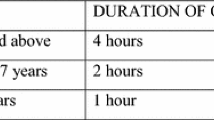This paper describes the violence safety program instituted at Elmhurst Hospital Center in Queens, New York City in 2001, which significantly reduced the use of restraints and seclusion department wide, while providing a safe and therapeutic environment for patient recovery. The hospital service and program instituted is described, followed by restraint and seclusion data since 1998, and the program’s results through 2003. Concurrent data in areas that could be affected by a reduction in restraint and seclusion such as self-injurious behaviors and altercations; use of emergency medication; use of special observation and length of stay data are also presented. In addition, types and frequency of alternative methods utilized to avoid restraints and seclusion are described.
Similar content being viewed by others
References
Fisher W: Restraint and seclusion: A review of the literature. American Journal of Psychiatry 151:1584–1591, 1994.
Bower F, McCullough C, Timmons M: A synthesis of what we know aboutthe use of physical restraints and seclusion with patients in psychiatric and acute care settings: 2003 update. The Online Journal of Knowledge Synthesis for Nursing 10:Document 1, 2003.
Forquer SL, Earle KA, Way BB, et al: Predictors of the use of restraint and seclusion in public psychiatric hospitals. Administration and Policy in Mental Health 23(6):527–532, 1996.
Kaltiala-Heino R, Tuohimaki C, Korkeila J, et al: Reasons for usingrestraint and seclusion in psychiatric care. International Journal of Law and Psychiatry 26:139–149, 2003.
Donat D: An analysis of successful efforts to reduce the use of seclusion and restraint at a public psychiatric hospital. Psychiatric Services 54:1119–1123, 2003.
Evans D, Wood J, Lambert L: Patient injury and physical restraint devices: A systematic review. Journal of Advanced Nursing 41(3):274–282, 2003.
Zun L: A prospective study of the complication rate of use of patient restraint in the emergency department. The Journal of Emergency Medicine 24(2):119–124, 2003.
Allen MH, Currier GW, Hughes DH, et al: Expert consensus panel for behavioral health emergencies. Postgraduate Medicine (Spec No):1–88, 2001.
Allen MH, Currier GW: Use of restraint and pharmacotherapy in academic psychiatric emergency services. General Hospital Psychiatry 26(1):42–19,2004.
Allen MH, Currier GW: Use of restraint and pharmacotherapy in academic psychiatric emergency services. General Hospital Psychiatry 26(1):42–19,2004.
Bezmen J, Weisil L: Utilized at Elmhurst Hospital, unpublished, 1988.
Author information
Authors and Affiliations
Corresponding author
Rights and permissions
About this article
Cite this article
Sullivan, A.M., Bezmen, J., Barron, C.T. et al. Reducing Restraints: Alternatives to Restraints on an Inpatient Psychiatric Service—Utilizing Safe and Effective Methods to Evaluate and Treat the Violent Patient. Psychiatr Q 76, 51–65 (2005). https://doi.org/10.1007/s11089-005-5581-3
Issue Date:
DOI: https://doi.org/10.1007/s11089-005-5581-3




